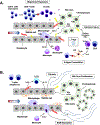Biliary Atresia in Children: Update on Disease Mechanism, Therapies, and Patient Outcomes
- PMID: 35868678
- PMCID: PMC9309872
- DOI: 10.1016/j.cld.2022.03.001
Biliary Atresia in Children: Update on Disease Mechanism, Therapies, and Patient Outcomes
Abstract
Biliary atresia is a rare disease but remains the most common indication for pediatric liver transplantation as there are no effective medical therapies to slow progression after diagnosis. Variable contribution of genetic, immune, and environmental factors contributes to disease heterogeneity among patients with biliary atresia. Developing a deeper understanding of the disease mechanism will help to develop targeted medical therapies and improve patient outcomes.
Keywords: Biliary atresia; Neonatal cholestasis; Pediatric liver transplantation; Transplant outcomes.
Copyright © 2022 Elsevier Inc. All rights reserved.
Conflict of interest statement
Disclosure The authors report no conflict of interest.
Figures



References
-
- The NS, Honein MA, Caton AR, et al. Risk factors for isolated biliary atresia, National Birth Defects Prevention Study, 1997–2002. Am J Med Genet A. 2007;143A(19):2274–2284. - PubMed
-
- Schreiber RA, Barker CC, Roberts EA, et al. Biliary atresia: the Canadian experience. J Pediatr. 2007;151(6):659–665, 665 e651. - PubMed
-
- Lin YC, Chang MH, Liao SF, et al. Decreasing rate of biliary atresia in Taiwan: a survey, 2004–2009. Pediatrics. 2011;128(3):e530–536. - PubMed
-
- Hopkins PC, Yazigi N, Nylund CM. Incidence of Biliary Atresia and Timing of Hepatoportoenterostomy in the United States. J Pediatr. 2017;187:253–257. - PubMed
-
- Chiu CY, Chen PH, Chan CF, Chang MH, Wu TC, Taiwan Infant Stool Color Card Study G. Biliary atresia in preterm infants in Taiwan: a nationwide survey. J Pediatr. 2013;163(1):100–103 e101. - PubMed
Publication types
MeSH terms
Grants and funding
LinkOut - more resources
Full Text Sources
Medical

